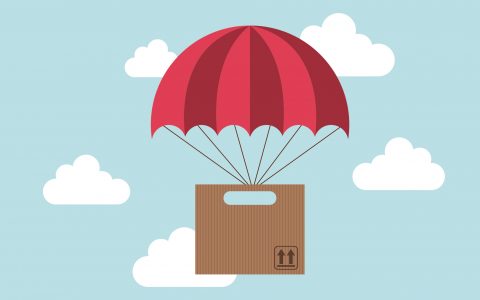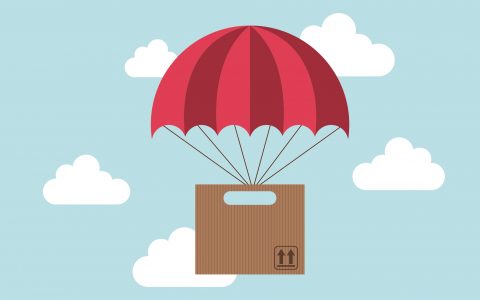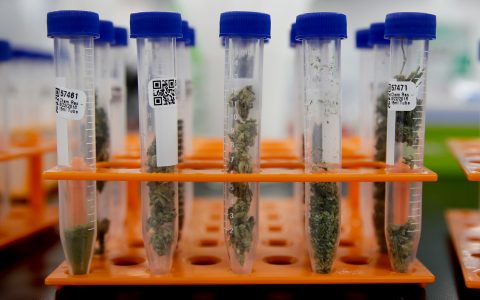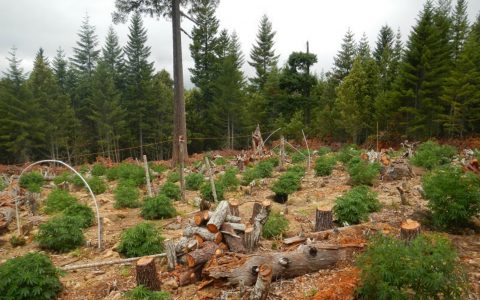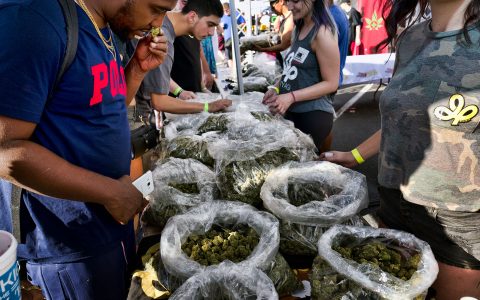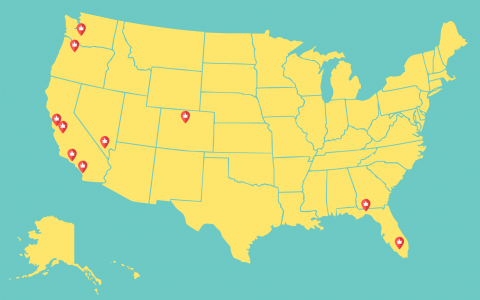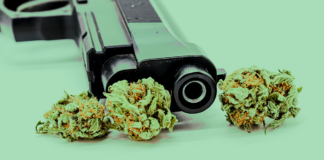Nearly a year after recreational sales kicked off in California, the world’s largest legal cannabis market is far from a well-oiled machine. But as the system takes shape, it’s hit a few notable benchmarks that show the industry’s slow, steady movement toward stability.
1. Delivery Services—Both Legal and Illegal—Continue to Spread
“Obviously the big issue so far is the debate over whether statewide delivery is legal or not,” Alex Traverso, the state Bureau of Cannabis Control’s assistant chief of communications, said in an email. “We believe it is.”
Regulators at the BCC have issued 142 licenses for cannabis delivery since the beginning of the year, but some local jurisdictions that have banned other elements of the cannabis industry argue they should be allowed to ban delivery services, too. The state disagrees, arguing that licensed delivery services should be able to drop off their products everywhere in California.
Dale Gieringer, director of California NORML, agrees with that sentiment, adding that he can’t think of any other consumer product—like, for instance, pizza—of which a local government could say “This can’t be delivered in our jurisdiction.” In addition, Gieringer said, there’s a large portion of people in California who don’t have adequate access to cannabis, and as long as that holds true, delivery will thrive—legally or illegally.
“There’s nothing harder to detect than an illegal delivery operation in the first place,” he said. “They’re rarely busted.”
2. More Than 19,000 Batches Have Been Lab Tested
As of Nov. 2, 19,707 batches of cannabis flower, edibles, oil cartridges, and other products had been tested by licensed laboratory facilities in California. Of these, more than 3,000 failed to meet testing standards. Most often this was due to inaccurate labeling, for example claiming a product contained more THC than it actually did. Other failing products contained unacceptable levels of pesticides, microbial impurities, or moisture.
While accurate labeling is crucial to ensure the safety and consistency of commercial cannabis, some critics claim the program is overly strict—and expensive. The average lab test costs between $500 to $800 to perform, said Gieringer of California NORML, and the standards for cannabis are far more rigorous than they are for most fruits and vegetables. “California is a highly regulatory state,” he said, “and they’ve written themselves into a corner with very tough requirements.”
3. Annual Licenses Are Finally Here
In early November, BCC issued its first 12 annual licenses to cannabis businesses. In stark contrast to temporary licenses, which had been issued up until that point and required little more than local approval and a diagram of the premises, annual permits entail an exhaustive application process that includes a rigorous environmental impact review under the California Environmental Quality Act, or CEQA.
While more difficult to secure, these annual licenses are good for an entire year and provide the dispensaries, distributors, and event organizers who receive them with a greater degree of permanence and overall sense of legitimacy, said Traverso at the BCC. It also gives operators a bit more procedural protection. If disputes arise and state regulators accuse a licensee of wrongdoing, for example, that operator can now take that decision to an appeals board and fight to maintain their license.
California’s transition to full licensing is also a huge step for the overall accountability of the cannabis industry. Permitted operators will be required to use the state’s track-and-trace system, intended to keep better tabs on movement through the supply chain and ensure that products remain within the legal system rather than being diverted to the illicit market.
4. Final Regulations Are Coming, Too
In addition to issuing annual licenses, California is also less than a a month away from releasing its final version of cannabis regulations. The reveal comes after months of public hearings, revisions to the language of the laws, and community feedback. The last round alone elicited more than 6,000 public comments, said Traverso.
Californians have debated a range of regulatory issues, including legal operating hours for retail operations, restrictions on delivery, and pesticide testing requirements. As a result of the most recent round of public comment, Traverso said, state regulators changed the licensing fee structure, which determines how much an applicant will have to pay the state based on their estimated annual sales. The new structure adds more tiers of payment, and accounts for some large-scale operators who are making tens of millions of dollars each year.
Because of the state’s tight turnaround time between the passage of Proposition 64 and the enactment date of legalization, implementing permanent regulations from the get-go just wasn’t a possibility, explained Traverso. The final regulations, currently expected to be issued in early December, are the “culmination of a tremendous amount of stakeholder engagement, public comment meetings and work amongst all three licensing authorities and the administration.”
Even the state’s “final” regulations aren’t set in stone, of course. Traverso expects that as the state’s legal industry matures, so will its regulatory structure.
5. Social Equity Programs Are (Slowly) Taking Shape
Most work around legalization in California has focused on implementing commercial regulatory structures—things like licenses and local rules. But as the industry transitions from an illicit market to a legal, regulated one, there’s also been increasing attention to the need for social equity.
In Los Angeles, there have been zero licenses issued so far through the social equity program.
The war on drugs, after all, was never fairly waged. People of color—and especially young black men—were disproportionately arrested and incarcerated for cannabis despite using and selling the drug at similar rates as white people. Now that it’s legal, many jurisdictions, including Los Angeles, San Francisco, and Oakland, are looking for ways to address that injustice and build more equitable cannabis industries by giving those most affected by the drug war a leg-up into the legal industry through priority license processing or financial support.
So far, though, it’s been slow going. A handful of cities have released basic guidelines for social equity programs, but only a few have begun issuing licenses to participants. In Los Angeles, there have been zero licenses issued so far through the social equity program. While many have praised its intent and structure, they’ve criticized the city’s complete lack of funding for the effort.
It’s a lack of of adequate resources that may be contributing to the overall stagnation of social equity growth in California, but that could soon change. State legislators in September approved SB 1264, which earmarks $10 million in funding for loans, fee waivers, and other support for local social equity programs. “Although California isn’t the first state to legalize the adult use and sale of cannabis,” one of the bill’s sponsors, Sen. Steven Bradford, said in a statement, “we can be the first state to do it right—by including those who were once punished but can now contribute.”
6. Tax Revenue Is Climbing
Although falling short of initial projections, cannabis tax revenue collected by the state has steadily increased throughout 2018, from $60.9 million in the first quarter of the year to more than $74 million in the second. These figures include state cultivation, excise, and sales taxes. The California Department of Tax and Fee Administration (CDTFA) has yet to release more recent sales figures.
Among other things, that money will go to community nonprofits, state health and safety initiatives, youth programs for drug education and prevention, and environmental protection efforts.
The CDTFA has also launched multiple efforts to more effectively collect cannabis fees, including launching a statewide compliance and outreach program that dispatches personnel to work with cannabis business owners and ensure they’re complying with tax law.
7. The Cannabis Job Market Is Booming
According to a report released this year from Vangst, a cannabis industry staffing agency, the number of cannabis job listings in the US grew by roughly 690% between Jan. 1, 2017 and Aug. 1, 2018. These include front-facing positions, such as budtenders and dispensary managers, as well as compliance managers and technical roles overseeing extraction operations. Mainstream professional hiring websites such as Monster and Indeed have embraced the new industry as well, and a simple search for “cannabis” yields hundreds of listings.
In fact, California is now the nationwide leader in cannabis employment, according to a Sacramento Bee article published earlier this year. Citing data from market research firm BDS Analytics, the newspaper reported that in 2017, California had 38,233 people directly employed in the cannabis industry and 18,165 people in related fields. By 2021, almost 100,000 Californians are projected to be employed in the cannabis industry.
The state’s own licensing agencies are on the hunt for employees, as well. With a current staff of about 80, the state’s Bureau of Cannabis Control, which oversees licensing and regulation throughout California, continues to grow considerably. The agency has funding to hire approximately 60 more employees this fiscal year in order to staff its new local liaison office, grants office, and enforcement and licensing divisions.


